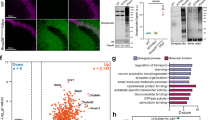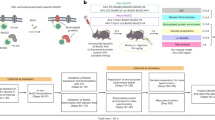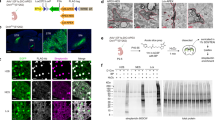Abstract
We develop an approach to tag proteomes synthesized by specific cell types in dissociated cortex, brain slices, and the brains of live mice. By viral-mediated expression of an orthogonal pyrrolysyl-tRNA synthetase-tRNAXXX pair in a cell type of interest and providing a non-canonical amino acid with a chemical handle, we selectively label neuronal or glial proteomes. The method enables the identification of proteins from spatially and genetically defined regions of the brain.
This is a preview of subscription content, access via your institution
Access options
Access Nature and 54 other Nature Portfolio journals
Get Nature+, our best-value online-access subscription
$29.99 / 30 days
cancel any time
Subscribe to this journal
Receive 12 print issues and online access
$209.00 per year
only $17.42 per issue
Buy this article
- Purchase on Springer Link
- Instant access to full article PDF
Prices may be subject to local taxes which are calculated during checkout


Similar content being viewed by others
Accession codes
References
Kitchen, R.R., Rozowsky, J.S., Gerstein, M.B. & Nairn, A.C. Nat. Neurosci. 17, 1491–1499 (2014).
Poulin, J.F., Tasic, B., Hjerling-Leffler, J., Trimarchi, J.M. & Awatramani, R. Nat. Neurosci. 19, 1131–1141 (2016).
Sharma, K. et al. Nat. Neurosci. 18, 1819–1831 (2015).
Belin, S. et al. Neuron 86, 1000–1014 (2015).
Elliott, T.S., Bianco, A., Townsley, F.M., Fried, S.D. & Chin, J.W. Cell Chem. Biol. 23, 805–815 (2016).
Elliott, T.S. et al. Nat. Biotechnol. 32, 465–472 (2014).
Nguyen, D.P. et al. J. Am. Chem. Soc. 131, 8720–8721 (2009).
Ernst, R.J. et al. Nat. Chem. Biol. 12, 776–778 (2016).
Kügler, S., Kilic, E. & Bähr, M. Gene Ther. 10, 337–347 (2003).
Jacque, C.M. et al. J. Neurol. Sci. 35, 147–155 (1978).
Roessmann, U., Velasco, M.E., Sindely, S.D. & Gambetti, P. Brain Res. 200, 13–21 (1980).
Brancaccio, M., Patton, A.P., Chesham, J.E., Maywood, E.S. & Hastings, M.H. Neuron 93, 1420–1435.e5 (2017).
Madisen, L. et al. Nat. Neurosci. 13, 133–140 (2010).
Atasoy, D., Aponte, Y., Su, H.H. & Sternson, S.M. J. Neurosci. 28, 7025–7030 (2008).
Schnütgen, F. et al. Nat. Biotechnol. 21, 562–565 (2003).
Kreitzer, A.C. Annu. Rev. Neurosci. 32, 127–147 (2009).
Yang, Y.Y., Ascano, J.M. & Hang, H.C. J. Am. Chem. Soc. 132, 3640–3641 (2010).
Yang, Y.Y., Grammel, M., Raghavan, A.S., Charron, G. & Hang, H.C. Chem. Biol. 17, 1212–1222 (2010).
Alvarez-Castelao, B. et al. Nat. Biotechnol. 35, 1196–1201 (2017).
Chin, J.W. Nature 550, 53–60 (2017).
Cox, J. & Mann, M. Nat. Biotechnol. 26, 1367–1372 (2008).
Cox, J. et al. J. Proteome Res. 10, 1794–1805 (2011).
Tyanova, S. et al. Nat. Methods 13, 731–740 (2016).
Huang, W., Sherman, B.T. & Lempicki, R.A. Nat. Protoc. 4, 44–57 (2009).
Zhou, Q. et al. Proc. Natl. Acad. Sci. 104, 16438–16443 (2007).
Acknowledgements
This work was supported by the Medical Research Council, UK (MC_U105181009 and MC_UP_A024_1008, to J.W.C., MC_U105170643 to M.H.) V.B. is supported by an MRC case studentship (Nikon). M.G.S. and L.C. acknowledge the support of the NC3Rs, ARUK and Cure PD. We are grateful to K. Heesom for mass spectrometry, and the MRC-LMB Mass Spectrometry Facility for additional mass spectrometry. We thank H. Bagci for contributions to the synthesis of AlkK, F. Morgese for assistance with AAV preparations, and the MRC biomedical staff at ARES and the Cambridge University Biomedical staff at Phenomics for their help.
Author information
Authors and Affiliations
Contributions
J.W.C. defined the direction of research. T.P.K., T.S.E., and R.J.E. designed all experiments. R.J.E. and V.B. designed the AAV vectors. V.B. performed the experiments in rat cortical preparations. T.P.K. performed the SCN slice experiments under the direction of M.H.H. L.C. performed experiments in live mice under the direction of M.G.S., E.C. performed experiments in live mice under the direction of M.T. T.S.E. provided ncAAs, analyzed lysates from live mice by fluorescent labeling and SDS-PAGE, performed the enrichments, and prepared samples for MS/MS. J.W.C., T.P.K., and R.J.E. wrote the paper with input from all authors.
Corresponding author
Ethics declarations
Competing interests
The authors declare no competing financial interests.
Integrated supplementary information
Supplementary Figure 1 Stochastic Orthogonal Recoding of Translation with Enrichment (SORT-E)
A non-canonical amino acid (ncAA) is recognized by an orthogonal aminoacyl-tRNA synthetase and loaded onto its cognate tRNAXXX, where XXX decodes a sense codon. The orthogonal tRNA decodes its cognate sense codons in competition with the natural tRNAs, leading to ncAA incorporation at sense codons and a substoichiometric, co-translational incorporation of the ncAA in the proteome. The amino acid can then be fluorescently labeled in SORT-M (not shown) or used to enrich the tagged proteome, in SORT with enrichment of tagged proteins (SORT-E), as shown. In SORT-E, the cleavable, biotinylated probe 2 is covalently coupled to amino acid 1 that has been incorporated via SORT. Tagged proteins can then be captured by solid-upported streptavidin. After stringent washing, the linker is cleaved under mild conditions to elute the enriched target proteins. Figure adapted from a prior publication: Elliott, T.S., Bianco, A., Townsley, F.M., Fried, S.D. & Chin, J.W. Tagging and Enriching Proteins Enables Cell-Specific Proteomics. Cell chemical biology 23, 805–815 (2016).
Supplementary Figure 2 Synthesized compounds used in this work
(1) Nɛ- (propargyloxycarbonyl)-L-lysine, “AlkK”; (2) azide diazobenzene biotin “ADB”.
Supplementary Figure 3 Optimization of SORT-M using an AlkK tagged E. coli protein extract.
A. SORT-M for the comparison of click ligands (THPA vs TBTA), reducing agents (TCEP vs sodium ascorbate) and dye concentrations. Reaction conditions; Alexa-647 azide (variable), CuSO4 (1mM), reducing agent (1 mM), ligand (0.1 mM), RT, 2 hrs. B. SORT-M for the optimization of copper concentration and ligand to copper ratio for both TBTA and THPTA ligands. Reaction conditions; Alexa-647 azide (0.1 mM), CuSO4 (varible), sodium ascorbate (1 mM), ligand (0.1 mM), RT, 2 hrs. C. Time course of SORT-M labeling using optimized conditions. Reaction conditions; Alexa-647 azide (0.1 mM), CuSO4 (1 mM), sodium ascorbate (1 mM), ligand (1 mM), RT. D. SORT-M to monitor the effect of aminoguanidine supplement on optimized click conditions. Reaction conditions; Alexa-647 azide. (0.1 mM), CuSO4 (1 mM), sodium ascorbate (1 mM), ligand (1 mM), aminoguanidine (0 or 5mM), RT, overnight. The experiments in AD were performed once with this gel configuration. The optimized conditions were tested ten times.
Supplementary Figure 4 Schematic of the vectors for AAV-mediated SORT
“ITR”, inverted terminal repeat; “WPRE”, woodchuck hepatitis virus post-transcriptional regulatory element; “PylT/PylS” pyrrolysyl tRNA/tRNA synthetase pair from M. mazei; “P2A”, self-cleaving peptide sequence derived from porcine teschovirus-1, “HGH pA”, human growth hormone poly-adenylation signal; “hU6”, human U6 RNA Pol III promoter; “hSynapsin I”, human Synapsin I promoter; “GfaABC1D”, minimal glial fibrillary acidic protein promoter.
Supplementary Figure 5 SORT-M labeling of tagged proteins from rat dissociated neuron-glia co-cultures
Lysates were prepared from dissociated neuron-glia co-cultures that had been transduced with the hSyn1-SORTCAU AAV in media supplemented with AlkK. Tagged proteins in the lysates were labelled with Az-AF647, analysed by SDS-PAGE and imaged for fluorescence. This experiment was independently repeated twice with similar results.
Supplementary Figure 6 Complete gel images from main and supplementary figures.
Dotted markings indicate parts used for figures. A. Figure 1D. B. Supplementary figure S8. C. Supplementary figure 10D and F and Figure 2G and J. D. Figure 2D. E. Figure 2L.
Supplementary Figure 7 Montage showing mCherry (PylS) expression in mice brains after stereotaxic injection of SORT AAVs.
Coronal sections (40μm) from anterior to posterior were mounted with DAPI, imaged by fluorescence microscopy and stitched post acquisition. A. hSyn1-SORTCAU injected into the striatum. B. hSyn1-SORTCAU injected into the dorsal hippocampus. C. GFAP-SORTCAU injected into the dorsal hippocampus. D., E. hSyn1-FLEX-SORTCAU injected into the dorsal hippocampus in Vgat-cre and Vglut-Cre mice, respectively. Scale bar 1000μm. Three animals were injected; two were used for SORT-M while one was used for fluorescence microscopy.
Supplementary Figure 8 Comparing striatal SORT tagging efficiency to E.Coli SORT-tagging
A. E.Coli were SORTCAU tagged with AlkK, as previously described2 and labeled with Az-A647. The SORT-M labeled E. coli proteome was serially diluted with unlabelled proteome to decrease the percentage of labeling from 100 %. Equal amounts of each of the resulting E. coli proteomes and the striatal proteomes were loaded. The striatal protein lysate is from a mouse unilateral injected with hSyn1-SORTCAU into the right hemisphere. We estimate from densitometry that SORT labeling in striatum corresponds to about 40% of the maximal E. coli labeling. B. Coomassie stain of the same gel as load control. The experiment was performed once.
Supplementary Figure 9 SORT-Tagging has minimal effects on the proteome of the mouse brain.
A. Multi scatterplot showing pairwise comparisons of LFQ values for “Control”, “AlkK”, “AAV” and “SORT” groups. The data show replicates from three mice, n=3 for each experimental condition. “Control” indicates WT mice, “AlkK” refers to mice fed the amino acid exactly as in a SORT experiment. “AAV” indicates mice injected with hSyn1-SORTCAU AAV, exactly as for SORT, but with no AlkK addition. “SORT” indicates mice used for SORT-E. B. Pairwise calculated Pearson correlation coefficients between all samples and plotted as a heat map. C. Heat map with an average of Pearson correlation coefficients from replica pairwise comparisons within each group. D. Weight of mice before and after SORT, n=15.
Supplementary Figure 10 Spatially controlled cell-type specific labeling in either neurons or glia.
A. Coronal section from a wild-type mouse brain unilaterally injected with hSyn1-SORTCAU AAV in the hippocampal right hemisphere. Red, mCherry fluorescence; Blue: DAPI stain. Scale bar is 1000 μm. B. Neurons in the right hemisphere are specifically targeted for SORT. mCherry fluorescence and anti-NeuN and anti-GFAP immunostaining for right Striatum for a mouse unilaterally injected with hSyn1-SORTCAU AAV into the right hemisphere. The arrows point to examples of mCherry positive cells. Scale bar is 50 μm. C. SDSPAGE analysis of protein extracts fluorescently labeled with Az-AF647. Extracts are from the right (R) and left (L) hippocampus of mice unilaterally injected with hSyn1-SORTCAU into the right (R) hippocampus and provided with AlkK. D., E., F., As for A.,B.,C. but using GFAP-SORTCAU AAV. The injections were done in three animals, with two animals being used for SORT-M and one animal being used for immunohistochemistry and subsequent fluorescence and confocal microscopy.
Supplementary Figure 11 Simplified schematic of synaptic connections in the straitum
The striatum contains an equal number of glia and neurons. Of the neurons the majority are Medium spiny neurons (MSNs), the remainder are interneurons; most of the interneurons are GABAergic. The Neurotransmitters produced by each type of cell (GABA, DOPA or Glutamic acid are indicated). The primary targets of SORT tagging are coloured red. Glutamatergic neurons from the Prefronatal cortex (PFC), Hippocampus, thalamus (THAL) and Amgdyla (AYG) synapse onto MSNs in the striatum. Dopaminergic neurons from the Substantia nigra pars compacta (SNc) and ventral tegmental area (VTA) synapse onto MSNs. Axons from MSNs synapse onto neurons in the Globus pallidus external (GPE), and Globus pallidus internal (Gpi)/ Substantia nigra (SNr)1. Reference: Yaeger et al. The ins and outs of the striatum: role in drug addiction. Neuroscience 301:539-541 (215)
Supplementary Figure 12 Optimizing AlkK based SORT-E in E. coli.
A. Optimizing ADB conjugation to a SORT tagged proteome. Comparison of click ligands (THPA vs TBTA) and ADB concentration. ADB ligation conditions; ADB (variable), CuSO4 (1mM), sodium ascorbate (1 mM), ligand (1 mM), aminoguanidine (5mM), RT, overnight. The ADB was detected by Steptavidin-HRP . This experiment was performed once in this gel configuration. B. SORT-E of E. coli protein extract tagged with AlkK using optimized reaction conditions. ADB ligation conditions; ADB (0.1 mM), CuSO4 (1 mM), sodium ascorbate (1 mM), TBTA (1 mM), aminoguanidine (5mM), RT, overnight. Approximately 30 ug of protein is isolated from an input of 35 mg of E. coli protein. This experiment was performed once in this gel configuration. C. Copious washes of proteins immobilized onto streptavidin beads during SORT-E does not effect the yield of eluted proteins. ADB ligation conditions; ADB (0.1 mM), CuSO4 (1 mM), sodium ascorbate (1 mM), TBTA (1 mM), aminoguanidine (5mM), RT, overnight. Beads washed with 1% SDS in PBS, proteins eluted with 1% SDS in PBS, 50 mM Na2S2O4. *Gel analysis of sampled from the last wash of X number of washes (X = 3, 6, 9, 12 or 15). Proteins were visualized by SyproRuby on SDS-PAGE. The experiment was performed twice in this configuration.
Supplementary Figure 13 Proteins identified by SORT-E with known synaptic function.
The relationship between the proteins identified as SORT-E IDs that are GABAergic, postsynaptic GABA, post synaptic glutamatergic and post synaptic dopaminergic, highlighted in Supplementary Table 1, are shown. The pink membranes correspond to neurons with cell bodies within the striatum. Proteins shown in grey were not identified as SORT-E IDs and are provided for context.
Supplementary information
Supplementary Text and Figures
Supplementary Figures 1–13 and Supplementary Table 1 (PDF 10680 kb)
Supplementary Data
Protein Identifications and quantifications (XLSX 832 kb)
Rights and permissions
About this article
Cite this article
Krogager, T., Ernst, R., Elliott, T. et al. Labeling and identifying cell-specific proteomes in the mouse brain. Nat Biotechnol 36, 156–159 (2018). https://doi.org/10.1038/nbt.4056
Received:
Accepted:
Published:
Issue Date:
DOI: https://doi.org/10.1038/nbt.4056
This article is cited by
-
Histone H4 proteoforms and post-translational modifications in the Mus musculus brain with quantitative comparison of ages and brain regions
Analytical and Bioanalytical Chemistry (2023)
-
Unraveling protein dynamics to understand the brain – the next molecular frontier
Molecular Neurodegeneration (2022)
-
Cell-type-specific labeling and profiling of glycans in living mice
Nature Chemical Biology (2022)
-
Reprogramming the genetic code
Nature Reviews Genetics (2021)
-
Advanced imaging and labelling methods to decipher brain cell organization and function
Nature Reviews Neuroscience (2021)



